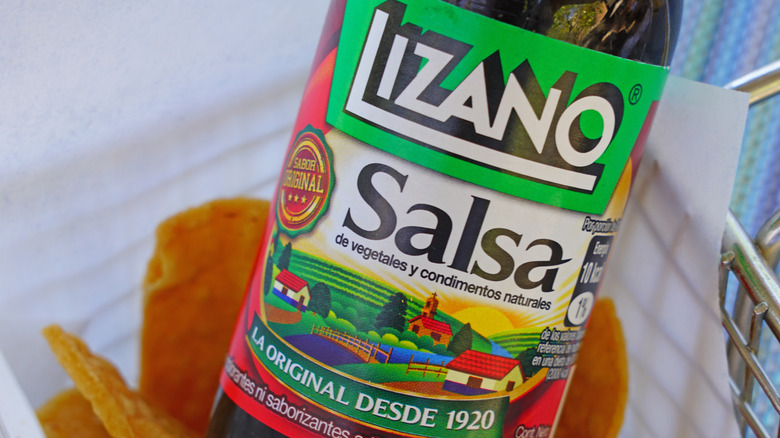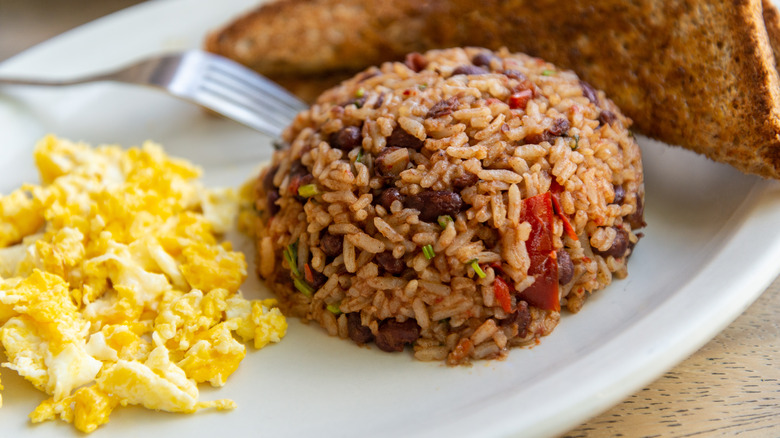Lizano Salsa Is Costa Rica's Must-Have Condiment
The all-purpose sauce that goes with everything — it's the holy grail of condiments, but you've probably made up your mind by now that it doesn't exist. After all, isn't every single one you try either too hot, too salty, too sweet — or just too darn bland?
While it's probably impossible to create a genuine "everything sauce," Cost Ricans lay claim to one that's pretty close — Lizano Salsa. Tourists seem to agree, hunting down this savory table sauce (often in vain) when they return home. So it's strange that Lizano isn't a lot more famous already, sharing the lofty condiment heights with sriracha or soy.
Yet in Costa Rica, the green-capped bottle is so ubiquitous that whenever you visit a local restaurant, you'll find it gracing the table beside the Tabasco and salt. Plus, you'd struggle to find a home or grocery store without it.
As well as being moreish, it's also versatile. Pura Vida Moms swears by its ability to enhance just about any Costa Rican classic you can slather it on, from pork tamales to tacos to empanadas.
Yet as The Takeout points out, you don't have to restrict it to Costa Rican cuisine — you can shake Lizano onto barbecue meats or roasted chicken or dip fries into it for lowkey kicks. Fans of the sauce say that it can enhance just about anything. But where exactly did it come from in the first place?
A secret recipe for over 100 years
Lizano Salsa began as a 1920 recipe concocted by Próspero Jiménez, owner of a bar in Alajuela. According to QCostaRica, when British condiment, Lea & Perrins Worcestershire Sauce, hit shelves across the country, Próspero felt he could do better. After some experimentation, Lizano Salsa was born.
That explains why this thin brown salsa is often compared to Worcestershire — plus, it's similar to another British classic, HP. No wonder then that its nickname is "salsa inglesa" (English sauce).
But what's inside the bottle? As you'd expect, the exact recipe is secret — in fact, no one seems to agree on the full ingredient list. If we're going by the Amazon listing, it's a blend of water, carrots, onions, cauliflower, cucumber, salt, sugar, cornstarch, turmeric, and other spices. The Culture Trip claims that chili peppers, molasses, dry mustard, and celery spice are also in the mix.
And what about the flavor? Amigo Foods describes Lizano as sweet, spicy, and tangy with mildly acidic notes. But as it has no heat, you can shake it liberally across dishes without fear. Yet while Lizano Salsa can enhance everything from steaks to seafood to scrambled eggs, is it just a shake-it-from-the-bottle sauce?
The pantry essential you didn't know you needed
It turns out that this Costa Rican classic is a bit of a cooking hack too.
For instance, as Evolving Table explains, it is a crucial ingredient in gallo pinto, the country's national dish. This black bean and white rice combo is served mainly for breakfast and just isn't complete without Lizano.
Plus, if you ever need to add a little acid and sweetness to a recipe, "salsa inglesa" can be a trick up your sleeve (via The Takeout). Like Worcestershire or Marmite, it can add an extra flavor dimension to stews, soups, and casseroles, as well as glazes and marinades.
Amigo Foods points out that it's also a tasty dipping sauce for tortilla chips — and you can use it to pep up everything from guacamole to charcuterie boards. If you're feeling daring, you can also sprinkle a smidge into Costa Rica's sweet rice dessert, arroz con leche, for a flavor contrast. And if you want to add pizzazz to a Bloody Mary, it could even give Tabasco a run for its money.
In fact, a whole lot of kitchen trickery can be found in this ordinary-looking sauce. Maybe there's a genie inside the bottle because once you open it, your culinary wish seems to be its command.


